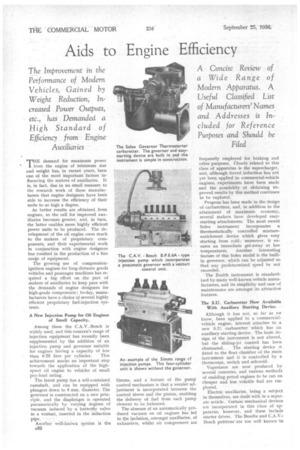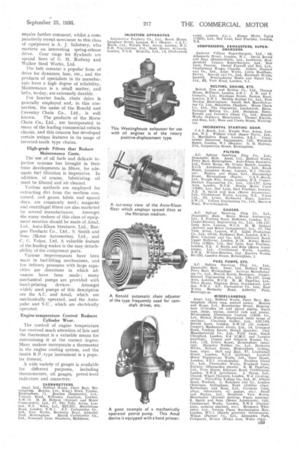Aids to Engine Efficiency
Page 102

Page 103

If you've noticed an error in this article please click here to report it so we can fix it.
The Improvement in the Performance of Modern Vehicles, Gained by Weight Reduction, Increased Power Outputs, etc., has Demanded a High Standard of Efficiency from Engine
Auxiliaries
A Concise Review of a Wide Range of Modern Apparatus. A Useful Classified List of Manufacturers' Names and Addresses is Included for Reference Purposes and Should be
Filed
THE demand for maximum power from the engine of minimum size and weight has, in recent years, been one of the most important factors influencing the makers of auxiliaries. It is, in fact, due in no small measure to the research work of these manufacturers that engine designers have been able to increase the efficiency of their units to so high a degree.
As better results are obtained from engines, so the call for improved auxiliaries becomes greater, and, in turn, the latter enables more highly efficient power units to be produced: The development of the oil engine owes much to the makers of proprietary components, and their experimental work in conjunction with engine designers has resulted in the production of a fine range of equipment.
The growing use of compressionignition engines for long-distance goods vehicles and passenger machines has required a big effort on the part of makers of auxiliaries to keep pace with the demands of engine designers for high-grade components ; to-day, manufacturers have a choice of several highly efficient proprietary fuel-injection systems.
A New Injection Pump for Oil Engines of Small Capacity.
Among these the C.A.V.-Bosch is widely used, and this concern's range of injection equipment has recently been supplemented by the addition of an injection pump and governor suitable for engines having a capaeity of less than 0.75 litre per cylinder. This achievement marks an important step towards the application of the highspeed oil engine to vehicles of small pay-load rating.
• The latest pump has a self-contained camshaft, and can be equipped with plungers down to 4 mm. diameter. The governor is constructed on a new principle, and the diaphragm is operated pneumatically by varying degrees of vacuum induced by a butterfly valve in a Venturi, inserted in the induction
. _ • . . Another well-known system is the c52
Simms, and a feature of the pump control mechanism is that a vernier adjustment is incorporated between the control sleeve and the pinion, enabling the delivery of fuel from each pump element to be balanced.
The absence of an automatically produced vacuum on oil engines has led to the inclusion, amongst auxiliaries, of exhausters, whilst air compressors are frequently employed for braking and other purposes. Closely related to this class of apparatus is the supercharger, and, although forced induction has not yet been applied to commercial-vehicle engines, experiments have been made and the possibility of obtaining improved results by this method continues to he explored.
Progress has been made in the design of carburetters, and, in addition to the attainment of maximum economy, several makers have developed easystarting attachments. The most recent Solex instrument incorporates a thermostatically controlled mixtureenrichment device which gives easy starting from cold ; moreover, it ensures an immediate get-away at low temperatures. Another interesting feature of this Solex model is the builtin governor, which can be adjusted so that any predetermined speed be not exceeded.
The Zenith instrument is standardized by many well-known vehicle manufacturers, and its simplicity and ease of maintenance are amongst its attractive features.
The SAL Carburetter Now Available With Auxiliary Starting Device.
Although it has not, so far as we know, been applied to a commercialvehicle engine, interest attaches to a new S.U. carburetter which has an auxiliary starting device. The basic design of the instrument is not altered, but the sliding-jet control has been eliminated. The starting device is fitted to the float chamber of the main instrument a,nd it is controlled by a thermostat, switch and solenoid.
• Vaporizers are now produced by several concerns, and various methods of enabling petrol engines to be run on cheaper and less volatile fuel are employed.
Electric auxiliaries, being a subject in themselves, are dealt with in a separate article. Certain mechanical devices are incorporated in this class of apparatus, however, and these include starter drives. The Bendix and C.A.V.Bosch patterns are too well known 10
require further comment, whilst a comparatively recent newcomer to this class of equipment is A; J. Salisbury, who markets an interesting spring-release drive. Gear rings for flywheels are special lines of G. H. Rodway and Walker Steel Works, Ltd.
The belt remains a popular form of drive for dynamos, fans, etc., and the products of specialists in its manufacture have a high degree of reliability. Maintenance is a small matter, and belts, to-day, are extremely durable. •
For heavier loads, chain drive is generally employed and, in this connection, the name of the Renold and Coventry Chain Co.,. Ltd., . is well known. The products of the Morse Chain Co., Ltd., are incorporated in many of the leading commercial-vehicle chassis, and this concern has developed certain unique features in its range of inverted-tooth type chains.
High-grade Filters that Reduce Maintenance Costs.
The use of oil fuels and delicate injection systems has brought in their train developments in filters, for adequate fuel filtration is imperative. In addition, of course, lubricating oil must be filtered and air cleaned.
Various methods are employed for extracting dirt from the medium concerned, and gauze, fabric and spaced discs, are commonly used ; magnetic and centrifugal filters are also marketed by several manufacturers. Amongst the many makers of this class of equipment mention should be made of Amal, Ltd., Auto-Klean Strainers, Ltd., Burgess Products Co., Ltd., S. Smith and Sons (Motor Accessories), Ltd., and C. G. Vokes, Ltd. A valuable feature of the leading makes is the easy detachability of the component parts.
Various improvements have been made in fuel-lifting mechanisms, and low delivery pressures with large capacities are directions in which advances have been made ; many mechanical pumps are provided with hand-priming devices. Amongst widely used pumps of this description are the A.C. and Amal, which are mechanically operated, and the Auto
pulse and which arc electrically operated.
Engine-temperature Control Reduces Cylinder Wear.
The control of engine temperature has received much attention of late and the thermostat is a valuable means for maintaining it at the correct degree. Many makers incorporate a thermostat in the engine cooling system, and the Smith R.P.-type instrument is a popular fitment.
A wide variety of gauges is available for different purposes, including thermometers, oil gauges, petrol-level indicators and ammeters.
























































































































































